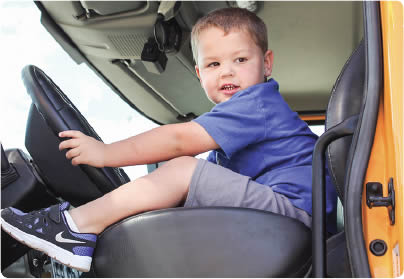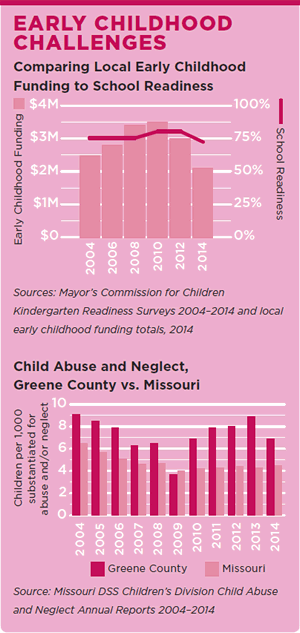EARLY CHILDHOOD
BLUE RIBBONS
Collaboration
Collaboration is at the heart of Springfield's early childhood blue ribbons. Although it was a blue ribbon in the 2013 CFR, it has become even more integral to our community. When limited resources are maximized through collaboration, the needs of children and families are better met. Recent examples of collaborations include:
- The Springfield-Greene County Library District continues to develop strong relationships with community agencies. It is pursuing grants to support literacy implementation by other organizations, expanding programming for young children and families and providing trainings to help other organizations understand early literacy and ways their staff can weave it into their work with parents to benefit children.
- A collaboration among Washington Avenue Baptist Church, Every Child Promise (ECP), Victory Trade School, Springfield Public Schools (SPS), and Lighthouse Child & Family Development Center is providing high-quality preschool, along with a wrap-around HUB to support children and families in the surrounding neighborhood.
- Discovery Center of Springfield, Ozarks Area Community Action Corporation (OACAC) Head Start and Missouri State University have collaborated to ensure our highest-need children have regular access to science through visits to the Discovery Center and classroom activities.
- Community Partnership of the Ozarks (CPO) and SPS Parents As Teachers (PAT) have collaborated to implement "K-Prep," a monthly parent-child program focused on building school-readiness skills within SPS elementary schools.
Local businesses recently have become more active early childhood collaborators:

- When CPO and PAT planned the first annual Big Rig Night in July 2014, 50 local businesses donated large vehicles and staffing to make the event possible. More than 1,600 families came to Battlefield Mall to explore and learn about transportation vehicles.
- Pediatricians within local health systems are distributing K-Kits to Springfield children at three-year-old well-child exams thanks to a Community Foundation of the Ozarks grant. Kits offer activities and supplies to encourage family interactions and skill-building.
Every Child Promise
In an ambitious attempt to establish a comprehensive local solution to improve the quality of life in Springfield and following the leadership of the Springfield News-Leader's 2013 CFR blue ribbon, ECP has focused on the youngest and most vulnerable in our community, children prenatal to six years. Its goal is to empower families with opportunities to access resources and support, so children start kindergarten "ready to learn." The ECP Strategic Plan, developed by citizens and community leaders, charts a bold vision for creating opportunities for our youngest citizens. The theory is simple: Improving access to services for all children prenatal to six years will improve critical metrics across the early child developmental spectrum and translate into more children ready for kindergarten, and ultimately improved K-12 scholastic performance. The group has raised $1.2 million to develop pilots with the goal of offering local, adaptable solutions to improving school readiness.
Springfield School Board Commitment
Improvement of local kindergarten readiness levels is impossible without school districts playing an integral role. The SPS Board of Education stepped up, demonstrating its understanding of the importance of children starting school ready to learn. The Board added an early childhood/pre-kindergarten section to its annual strategic plan, allotted local funds to hire additional parent educators for PAT, and expanded its summer school program for pre-K students.
Dolly Parton Imagination Library
Since the May 2013 announcement that the Dolly Parton Imagination Library was coming to Greene County, approximately 3,000 children have been registered for the program and have received quality children's books. The early literacy program operates on a straightforward principle: Get quality, age-appropriate books into the hands of enrolled children monthly, from birth through age five. The goal is to help develop childhood literacy skills before a child ever sets foot in a kindergarten classroom. The Imagination Library's vision is to give children the gift of reading.
All of our community's children, whether or not they're living to their full potential, are the next generation of our workforce. Everyone benefits from a community where families strive to ensure that the next generation will have a better quality of life than they did.TIM ROSENBURY
SPRINGFIELD PUBLIC SCHOOLS BOARD OF EDUCATION
United Way of the Ozarks is the lead fundraising partner, and the Springfield-Greene County Library administers the program. Solely supported by donations and sponsorships from organizations, businesses and individuals, the program uses all funds raised to purchase and distribute books from the Dollywood Foundation. The first phase of the program serves children in ZIP codes 65802, 65803, 65806 and 65807, with a long-range goal of serving all children in Greene County.
RED FLAGS
Kindergarten Readiness
Kindergarten readiness continues to be a red flag as an area where many Springfield children struggle. In the recent 2014 Kindergarten Readiness Study, teachers report 28 percent of local students are not prepared to enter kindergarten based on DIAL 4 scores and social and emotional skill development. This latest number represents a 40 percent increase of unprepared students from the 2010 study.
Drivers of the negative change include an increase in child poverty, fewer pre-K slots in major educational programs, inadequate subsidy rates to help parents afford quality pre-school, financial hardships on families hit by the recession, and limited family support resources. Current needs outstrip capacity for services addressing these issues due to cutbacks in all funding sources—federal, state, private grants, and local donors.
The constant seesaw effect of these cuts creates difficulty in maintaining quality programs and services including attracting and retaining quality teachers, keeping classroom space, paying staff competitive wages, and having services needed to really make a difference in the readiness level. Research shows children who receive high-quality pre-K experiences are more prepared for kindergarten, and typically more successful in school and life. Affording access to effective, sustained high-quality programs requires dedicated public and private support. The ECP's success will be measured based on improvements to the "Kindergarten Readiness" level established in the 2014 study.
Funding Instability
An ongoing threat to the local early childhood landscape is the instability of local, state and federal funding. Without dedicated, reliable funding streams, it is difficult for grant-funded programs to remain stable. Stability is at the heart of quality early childhood services. In 2013, Congress enacted the sequester, which cut millions of dollars in federal funding from local early childhood programming. In Missouri, a similar strangulation of programming occurred when the governor withheld much of the early childhood funding. In FY 2014, the sequestered funding was restored. In early 2015, withheld state funding was released. As a result, early childhood programs ride a pendulum that swings rapidly between scaling back and ramping up, with changing expectations and regulations. The impact of the pendulum swing is inefficiency and waste. If the funding source reduces funding levels or withholds a portion of the funds, which was the case with both the federal sequester and the Governor's decision to withhold state dollars, programs must rapidly respond by scaling back. That can include furloughing staff, dispersing equipment and materials and restricting access to services. When funds are restored, programs must again rapidly respond by ramping up, hiring and training new staff, acquiring space, equipment, and/or materials, and enrolling new participants. Funding instability affects programs' ability to recruit and retain employees and creates a marketing and messaging issue when recruiting clients.
Child Abuse and Neglect
Child abuse and neglect rates continue to be a concern in Greene County, having been an issue in every CFR since 2005. Although rates declined from 2004 to 2007, in 2008 abuse numbers trended up once again. In 2013, the rate climbed to 8.93 children per 1,000 substantiated for abuse and neglect. There is a slight glimmer of hope, as 2014 showed the rates declining. However, Greene County rates remain much higher than Missouri state averages. Our support organizations continue to buckle under the burden of children entering the system, as resources are not keeping pace with abuse and neglect rates.
While 2013 state statute changes have clarified the mandated reporter role, additional changes in public policy and law, along with funding for enforcement of both, remain critical to protecting our children from this devastating injustice. Our community needs to find a way to address the issues, so children are not forced to endure the trauma of abuse and neglect.
Adequate Response to Children with Challenging Behavior
An increasing number of young children in our community exhibit challenging behaviors, including violent outbursts, destruction of property and harm to self or others. Children with challenging behaviors are at increased risk for abuse, being expelled from their child care program and lacking appropriate skills to succeed in kindergarten. Challenging behaviors not addressed during the early childhood years are often exacerbated as children enter the elementary years. This often leads to later expulsions and drop outs among these children. Resources in our community for children with challenging behaviors, their families and early childhood programs who care for them are lacking. Studies suggest that in Missouri, 12 preschool children per 1,000 are expelled each year, which is 17 times higher than the K-12 rate. An accurate accounting of children with challenging behaviors in our community who are being expelled from early childhood programs is needed, as well as funding to support corresponding strategies for reducing such behaviors. Possible strategies include increasing children's social/emotional skills, increasing child and family protective factors, reducing class sizes in early childhood programs, more day treatment for children with extreme challenging behaviors, and early childhood mental health consultation.

